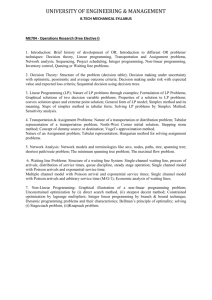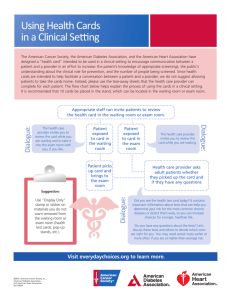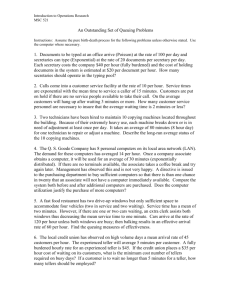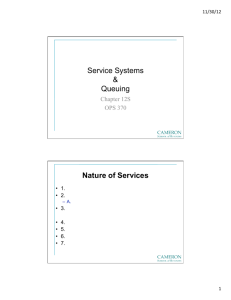Lecture Notes for Week 8
advertisement
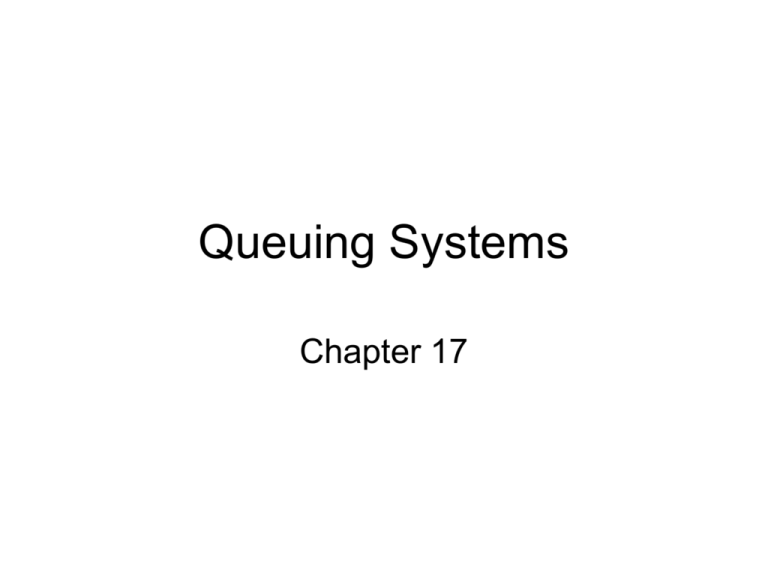
Queuing Systems Chapter 17 Chapter Topics Elements of Waiting Line Analysis Single-Server Waiting Line System Undefined and Constant Service Times Finite Queue Length Finite Calling Problem Multiple-Server Waiting Line Addition Types of Queuing Systems Overview People and products spent significant amount of time in waiting lines Providing quick service is an important aspect of customer service Trade-off between the cost of improving service and the costs associated with making customers wait A probabilistic form of analysis Results are referred to as operating characteristics Results are used to make decisions Elements of Waiting Line Analysis Waiting lines form because people arrive at a service faster than they can be served Not arrive at a constant rate nor are they served in an equal amount of time Have an average rate of customer arrivals and an average service time Decisions are based on these averages for customer arrivals and service times Formulas are used to compute operating characteristics Single-Server Waiting Line System Components include: Arrivals (customers), servers, (cash register/operator), customers in line form a waiting line Factors to consider: queue discipline. nature of the calling population arrival rate service rate. Component Definitions Queue Discipline: order in which customers are served (FIFO, LIFO, or randomly) Calling Population: source of customers (infinite or finite) Arrival Rate: Frequency at which customers arrive at a waiting line according to a probability distribution (Poisson distribution) Service Rate: Average number of customers that can be served during a time period (negative exponential distribution) Single-Server Waiting Line System Single-Server Model Assumptions: An infinite calling population A first-come, first-served queue discipline Poisson arrival rate Exponential service times Symbology: = the arrival rate (average number of arrivals/time period) = the service rate (average number served/time period) Customers must be served faster than they arrive ( < ) Single-Server Queuing Formulas Probability that no customers are in the waiting line: Po 1 Probability that n customers are in the waiting line: n n Pn Po 1 Average number of customers in system: waiting line: 2 Lq L and SSingle-Server Queuing Formulas Average time customer spends waiting and being served: W 1 L Average time customer spends waiting in the queue: Wq Probability that server is busy (utilization factor): Probability that server is idle: I 1U 1 U Characteristics for Fast Shop Market = 24 customers per hour arrive at checkout counter = 30 customers per hour can be checked out Po 1 (1 - 24/30) .20 probabilit y of no customers in the system L 24/(30 - 24) 4 customers on the avg in the system 2 Lq (24)2/[30(30 - 24)] 3.2 customers on the avg in the waiting line Characteristics for Fast Shop Market W 1 L 1/[30 - 24] 0.167 hour (10 min) avg time in the system per customer Wq 24/[30(30 - 24)] 0.133 hour (8 min) avg time in the waiting line U 24/30 .80 probabilit y server busy, .20 probabilit y server will be idle Steady-State Operating Characteristics Utilization factor, U, must be less than one: U < 1,or / < 1 and < . Ratio of the arrival rate to the service rate must be less than one or, the service rate must be greater than the arrival rate Server must be able to serve customers faster than the arrival rate in the long run, or waiting line will grow to infinite size. Single-Server Waiting Line System Effect of Operating Characteristics (1 of 6) Wish to test several alternatives for reducing customer waiting time: Addition of another employee to pack up purchases Addition of another checkout counter. Alternative 1: Addition of an employee raises service rate from = 30 to = 40 customers Cost $150 per week, avoids loss of $75 per week for each minute of reduced customer waiting time System operating characteristics with new parameters: Po = .40 probability of no customers in the system L = 1.5 customers on the average in the queuing system Effect of Operating Characteristics System operating characteristics with new parameters (continued): Lq = 0.90 customer on the average in the waiting line W = 0.063 hour average time in the system per customer Wq = 0.038 hour average time in the waiting line per customer U = .60 probability that server is busy and customer must wait I = .40 probability that server is available Average customer waiting time reduced from 8 to 2.25 minutes worth $431.25 =(8-2.25)($75) per week. Effect of Operating Characteristics Alternative 2: Addition of a new checkout counter ($6,000 plus $200 per week for additional cashier). = 24/2 = 12 customers per hour per checkout counter = 30 customers per hour at each counter System operating characteristics with new parameters: Po = .60 probability of no customers in the system L = 0.67 customer in the queuing system Lq = 0.27 customer in the waiting line W = 0.055 hour per customer in the system Wq = 0.022 hour per customer in the waiting line U = .40 probability that a customer must wait I = .60 probability that server is idle Effect of Operating Characteristics Savings from reduced waiting time worth $500= (81.33)($75) per week - $200 = $300 net savings per week. After $6,000 recovered, alternative 2 would provide $300 281.25 = $18.75 more savings per week. Undefined and Constant Service Times Constant occurs with machinery and automated equipment Constant service times are a special case of the singleserver model with undefined service times Queuing formulas: Po 1 Lq Wq Lq 2 2 2 / 21 / L Lq 1 W Wq U Undefined Service Times Example Data: Arrival rate of 20 customers per hour (Poisson distributed); undefined service time with mean of 2 minutes, standard deviation of 4 minutes. Operating characteristics: 20 .33 probability that machine not in use Po 1 1 30 2 2 2 / 2 2 2 20 1/15 20 / 30 Lq 21 / 21 20 / 30 3.33 employees waiting in line L Lq 3.33 (20/ 30) 4.0 employees in line and using the machine Undefined Service Times Example (2 of 2) Operating characteristics (continued): Wq Lq 3.33 0.1665 hour 10 minutes waiting time 20 1 0.1665 1 0.1998 hour W Wq 30 12 minutes in the system 20 67% machine utilizatio n U 30 Constant Service Times Formulas No variability in service times; = 0. Substituting = 0 into equations: 2 2 2 2 2 2 2 / / 0 / 2 Lq 21 / 21 / 21 / 2 All remaining formulas are the same Constant Service Times Example Inspecting one car at a time; constant service time of 4.5 minutes; arrival rate of customers of 10 per hour (Poisson distributed). Determine average length of waiting line and average waiting time = 10 cars per hour, = 60/4.5 = 13.3 cars per hour Lq (10)2 2 1.14 cars waiting 2 ( ) 2(13.3)(13.3 10) Wq Lq 1.14 0.114 hour or 6.84 minutes waiting time 10 Finite Queue Length Length of the queue is limited. Operating characteristics: M is the maximum number in the system: n 1 / for n M Po Pn (Po) 1 ( / )M 1 M 1 / ( M 1 )( / ) L 1 / 1 ( / )M 1 W L (1 PM ) Lq L (1PM ) 1 Wq W Finite Queue Length Example Limited parking space (one vehicle in service and three waiting for service) Mean time between arrivals of customers is 3 minutes and mean service time is 2 minutes (both inter-arrival times and service times are exponentially distributed) Maximum number of vehicles in the system equals 4. Operating characteristics for = 20, = 30, M = 4: Po 1 / 1 20/ 30 .38 prob. that system is empty 1 ( / )M 1 1 (20/ 30)5 PM (Po) nM 4 (.38) 20 .076 prob. that system is full 30 Example-Cont. Average queue lengths and waiting times: M 1 ) / )( 1 M ( / L 1 / 1 ( / )M 1 5 ) 30 / 20 )( 5 ( 30 / 20 1.24 cars in the system L 1 20 / 30 1 (20 / 30)5 Lq L (1PM ) 1.24 20(1.076) 0.62 cars waiting 30 W L 0.067 hours waiting in the system 1.24 (1 PM ) 20(1.076) 1 0.067 1 0.033 hour waiting in line Wq W 30 Finite Calling Population There is a limited number of potential customers that can call on the system. Operating characteristics (Poisson arrival and exponential service times): 1 Po n N N! ( N n)! n0 where N population size, and n 1, 2,...N n Po Pn N! ( N n)! L Lq (1 Po) Lq N (1 Po) Wq Lq ( N L) 1 W Wq Finite Calling Population Example 20 machines; each machine operates an average of 200 hours before breaking down; average time to repair is 3.6 hours; breakdown rate is Poisson distributed, service time is exponentially distributed. Is repair staff sufficient? = 1/200 hour = .005 per hour = 1/3.6 hour = .2778 per hour N = 20 machines Finite Calling Population Example Po 1 .652 n 20 20! .005 (20 n)!.2778 n0 Lq 20 .005 .2778 1.652 .169 machines waiting .005 L .169 (1.652) .520 machines in the system Wq .169 1.74 hours waiting for repair (20 .520)(.005) W 1.74 1 5.33 hours in the system .2778 System seems inadequate. Multiple-Server Waiting Line Two or more independent servers in parallel serve a single waiting line; first-come, first-served basis Assumptions: First-come first-served queue discipline Poisson arrivals, exponential service times Infinite calling population. Parameter definitions: = arrival rate (average number of arrivals per time period) = the service rate (average number served per time (channel) period) per server c = number of servers c = mean effective service rate for the system (must exceed arrival rate) Multiple-Server Waiting Line: Formulas Po nc1 1 n! n0 n 1 1 c! c c c prob. no customers in system n 1 Pn nc Po for n c c!c n 1 Pn n Po for n c prob. of n customers in system L ( / )c Po average customers in the system (c 1)!(c )2 W L average time customer spends in the system average number of customers in the queue Lq L 1 Lq average time customer is in the queue Wq W c c 1 Pw Po probabilit y customer must wait for service c! c Example = 10, = 4, c = 3 Po 1 1 10 0! 4 0 1 1 10 1 10 1! 4 2! 4 2 3 3(4) 10 1 3! 4 3(4) 10 .045 prob. of no customers 3 L (10)(4)(10 / 4) (.045) 10 6 customers on average in service department 4 (31)![3(4) 10]2 W 6 0.60 hour average customer t ime in the service department 10 Lq 6 10 3.5 customers on the average waiting to be served 4 Wq 3.5 0.35 hour average waiting time in line per customer 10 3 3(4) (.045) .703 prob. customer must wait for service 10 1 Pw 3! 4 3(4) 10 Notation Used for Waiting Line Models • Kendal suggested A/B/k – A: Denotes the prob. Distribution for the arrival – B: Denotes the prob. Distribution for the service time – k: Denotes of channels • Letters commonly used – M: designates a Poisson prob. Dist. For the arrivals or an exp. prob. dist. for the service time – D: designates that arrivals or the service time is deterministic – G: designates that the arrivals or the service time has a general prob. Dist. With a known mean and variance – M/M/1: single-server with Poisson arrivals and exp. service time – M/M/2: two-server with Poisson arrivals and exp. service time – M/G/1: single-server with Poisson arrivals and arbitrary service time Problem#1 • A single server queuing system with an infinite calling population and a FIFO discipline has the following arrival and service rates: 16 customers/hour 24 customers/hour Determine P0, P3, L, Lq, W, Wq, and U
